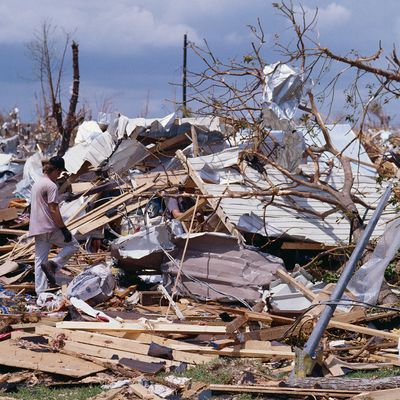
Hurricane Irma is coming and it’s going to be a beast. That much we know. But there’s still plenty about the massive storm that is unclear, including its path, when it will make landfill and how the areas likely to be hardest hit will respond.
Right now, Irma is expected to reach South Florida as a category 4 storm, meaning it will bring sustained winds of at least 130 mph. By some, estimates, the winds could be swirling as fast as 150 mph by the time Irma makes landfall, putting it among the strongest hurricanes to ever hit Florida. There is even some indication that Irma may be speeding up, with the possibility that it regains category 5 status.
But it’s not just that wind that Floridians have to worry about. There’s also the deadly storm surge, coastal flooding, and in some cases, increased potential for tornadoes. And no area is under more threat than Miami and its suburbs, home to 4.5 million people.
On Friday morning, the National Weather Service put out four maps of South Florida showing the severity of Irma’s different threats. Miami and the surrounding areas are the only place where wind, storm surge, flooding, and tornado threats are all at their highest levels.
The good news is that Miami might be the city most well equipped to handle a storm of Irma’s strength. In 1992, Hurricane Andrew, the last category 5 storm to hit the U.S., destroyed 125,000 homes in the area and caused $26 billion in damages. The storm largely missed downtown Miami, but laid waste to the city of Homestead, which sits southwest of the larger city. In the aftermath of Andrew, South Florida remade itself to ensure that a similar storm would not cause comparable devastation.
Building codes in Broward and Miami-Dade Counties require homes to be able to withstand winds of 130 mph. Hurricane-ready windows and roofs are now far more common than they once were and mobile homes fastened to stronger foundations are less likely to be tossed into air.
These preparations make Miami more ready than any other city for the aggressive winds Irma is promising, but there are still plenty of questions. The ability of Miami’s many high-rises to deal with the winds is a particular mystery. In the past 15 years, more than 40,000 condos in high-rises have gone up east of I-95, putting them well within the Irma evacuation zone. Since they went up after Andrew, these buildings were built with some of the country’s most stringent regulations, which require them to withstand winds of 175 mph. That doesn’t mean there won’t be damage though. Hurricane Wilma, which blew through in 2005 as a category 2 storm, blew out an untold number of windows in Miami buildings constructed after Andrew.
Then there is the issue of flying debris and unstable structures, such as cranes. There are around 25 currently perched above Miami, a symbol of the city’s construction boom. These cranes are made to withstand winds of 145 mph, but Irma is poised to brings winds stronger than that.
Even if the building codes and precautions taken by homeowners are able to mitigate the damage of Irma’s winds, the storm surge will be impossible to stop. The National Weather Service has called it “life-threatening,” and warned of “structural damage to buildings, with many washing away.” The Wall Street Journal explains how the storm surge originates:
The surges are created when the high wind of a hurricane forces ocean waters onshore. The highest waves are typically centered on the leading right side of the storm, where counterclockwise winds in the Northern Hemisphere push the bulk of a hurricane’s destructive force. The surge waves are made even higher when they travel across shallow coastal waters, said Robert Bohlin, a meteorologist with the Central Pacific Hurricane Center in Honolulu.
Miami is fortunate that its coastal waters are not as shallow as those on Florida’s Gulf of Mexico side, and the depth should reduce the size of the storm surge. The National Oceanic and Atmospheric Administration expects the storm surge to hit Miami to be around nine feet, significantly smaller than the record-high 28-foot storm surge that hit New Orleans during Hurricane Katrina.
But even a nine-foot surge could wreak havoc on Miami’s high-rises, which are likely to take a sustained pounding from waves. “Downtown office buildings there are not designed for surge,” Robert Bea of the University of California’s Center for Catastrophic Risk Management told the WSJ.
With the storm surge also comes the threat of flooding. Much of South Florida is at or below sea level, and with and endless array of rivers, lakes and canals, it’s not just the coast that’s at risk for flooding. “If extreme force is pressed upon the ocean it will snake its way inland however it can,” Jamie Rhome, storm surge expert at the National Hurricane Center, told the Miami Herald.
If there’s a bright side to any of this, it’s that Irma is not expected to bring a catastrophic amount of rainfall, unlike Hurricane Harvey, which stationed itself over Houston and refused to leave. Forecasters are calling for eight to 10 inches of rain and officials are confident that aging infrastructure, such as the Herbert Hoover Dike surrounding Lake Okeechobee, will be able to handle the water.
At this point, with Irma bearing down on South Florida, the only thing left to do is to get people out of its path and to begin preparing for the disaster that will follow. Florida governor Rick Scott is already soliciting donations.





























